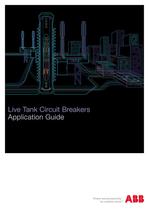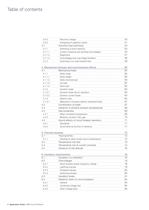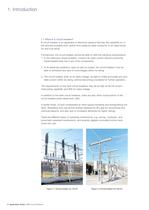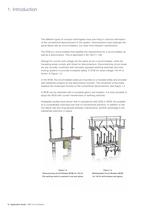
Catalog excerpts

zz7z7P Live Tank Circuit Breakers Application Guide Power and productivity for a better world1
Open the catalog to page 1
ABB AB High Voltage Products Department: Marketing & Sales Text: Tomas Roininen, Carl Ejnar Slver, Helge Nordli, Anne Bosma, Per Jonsson, Anders Alfredsson Layout, 3D and images: Mats Findell, Karl-Ivan Gustavsson SE-771 80 LUDVIKA, Sweden 2 Application Guide | ABB Circuit Breakers
Open the catalog to page 2
Table of contents 1. Introduction 8 1.1 What is a circuit breaker? 8 1.2 Why do we need circuit breakers? 9 1.3 Different types of switching 9 1.4 Disconnecting and withdrawable circuit breakers 9 1.5 Circuit switcher 11 1.6 Environmental aspects 11 2. Live tank circuit breaker designs and operating princi 2.1 Historical development 12 2.2 Main components 13 2.2.1 Breaking unit 14 2.2.2 Support insulator 14 2.2.3 Operating mechanism 14 2.2.4 Support structure 14 2.3 Additional components 15 2.3.1 Grading capacitors 15 2.3.2 Preinsertion resistors 15 2.3.3 Cabinets for central control 15 2.4...
Open the catalog to page 3
Table of contents 3.6.2 Recovery voltage 50 3.6.3 Energizing of capacitor banks 51 3.7 Inductive load switching 53 3.7.1 Switching of shunt reactors 53 3.7.1.1 Current chopping and resulting overvoltages 54 3.7.1.2 Reignitions 57 3.7.1.3 Overvoltages and overvoltage limitation 58 3.7.2 Switching of no-load transformers 59 4. Mechanical stresses and environmental effects 60 4.1 Mechanical loads 60 4.1.1 Static loads 60 4.1.1.1 Dead weight 60 4.1.1.2 Static terminal load 60 4.1.1.3 Ice load 62 4.1.1.4 Wind load 62 4.1.2 Dynamic loads 63 4.1.2.1 Dynamic loads due to operation 63 4.1.2.2...
Open the catalog to page 4
Scope This document gives background information for slection of the best possible circuit breaker solution for each particular application. The guide addresses utility, consultant and project engineers who specify and apply high-voltage circuit breakers. The guide addresses live tank circuit breakers in general for voltages up to 800 kV. The most usual requirements on a circuit breaker are mentioned, such as the capabilities to handle network stresses, insulation levels, mechanical forces and ambient conditions. The construction of circuit breaker poles and operating mechanisms will be...
Open the catalog to page 7
1. Introduction 1.1 What is a circuit breaker? A circuit breaker is an apparatus in electrical Systems that has the capability to, in the shortest possible time, switch from being an ideal conductor to an ideal insula-tor and vice versa. Furthermore, the circuit breaker should be able to fulfill the following requirements: 1. In the stationary closed position, conduct its rated current without producing impermissible heat rise in any of its components. 2. In its stationary positions, open as well as closed, the circuit breaker must be able to withstand any type of overvoltages within its...
Open the catalog to page 8
1.2 Why do we need circuit breakers? The circuit breaker is a crucial component in the substation, where it is used for coupling of busbars, transformers, transmission lines, etc. The most important task of a circuit breaker is to interrupt fault currents and thus protect electric and electronic equipment. The interruption and the subsequent reconnection should be carried out in such a way that normal operation of the network is quickly restored, in order to maintain system stability. In addition to the protective function, the circuit breakers are also applied for intentional switching...
Open the catalog to page 9
1. Introduction The diffrent types of compact switchgears have one thing in common limination of the conventional disconnectors in the system. Disconnectors have basically the same failure rate as circuit breakers, but need more frequent maintenance. The DCB is a circuit breaker that satisfies the requirements for a circuit breaker as well as a disconnector. This is described in IEC 62271-108. Ratings for current and voltage are the same as for a circuit breaker, while the insulating levels comply with those for disconnectors. Disconnecting circuit break-ers are normally combined with...
Open the catalog to page 10
1.5 Circuit switcher The circuit switcher is a lighter "economy variant" of the live tank circuit breaker. The construction is similar and it can be applied for interruption of short-circuit currents, protection and switching of capacitor- and reactor-banks, transformers, lines and cables in accordance with IEC and IEEE/ANSI standards. The fault clearing rating is somewhat lower than that of the corresponding circuit breaker, and the operating times are longer. IEEE C37.016 specifies the requirements for circuit switches. 1.6 Environmental aspects Circuit breakers are installed in all kinds...
Open the catalog to page 11
2. Live tank circuit breaker designs and operating principles 2.1 Historical development The air blast circuit breakers, which used compressed air as the extinguishing medium, had the advantage of high interrupting capability and short interruption times. However, the breaking units (interrupters) had limited dielectric withstand capabil-ity and, as can be seen in Figure 2.1, a circuit breaker for 420 kV needed up to 10 breaking elements in series per phase. The arc extinction required high air pressure, around 2 MPa, which meant that the risk of leakage was high. Installation, mainteͭnance...
Open the catalog to page 12
2.2 Main components Live tank circuit breakers consist of four main components: - One or more breaking units (interrupters) - Support insulator - One or more operating mechanisms - Support structure (stand) The figures below shows the different parts of SF6 circuit breakers. Figure 2.2. Three-pole operated circuit Figure 2.3. One pole of a single-pole operated breaker with one interrupter per pole. circuit breaker with two interrupters per pole. Circuit breaker components 1. Breaking unit 5. Trip mechanism 9. Grading capacitor (if required) 2. Support insulator 6. Gas supervision (on...
Open the catalog to page 13
2. Live tank circuit breaker designs and operating principles 2.2.1 Breaking unit The insulating housing is made of porcelain or composite material and is filled with pressurized SF6 gas. The breaking unit is subjected to potential, i.e. it is "live", hence the term "live tank" circuit breaker. One circuit breaker pole can even consist of two or more breaking units in series. The number of breaking units is dependent on the system voltage and the require-ments on interrupting capability. The function of the extinction chamber is described under 2.4.2 "Principles of arc extinction." 2.2.2...
Open the catalog to page 14All ABB AG catalogs and technical brochures
-
PASS – Plug And Switch System
12 Pages
-
Transportation
11 Pages
-
MFM - Multi Functional Modules
16 Pages
-
Capacitor Bank Controller CQ900
10 Pages
-
HMC operating mechanism
4 Pages
Archived catalogs
-
High Voltage Surge Arresters
116 Pages
-
Gas-insulated Switchgear ENK
8 Pages
-
Gas-insulated Switchgear ELK-04
32 Pages
-
PASS M00, PASS M0, PASS M0S
24 Pages
-
ABB Composite Insulators
24 Pages
-
COMPASS
20 Pages
-
Disconnecting circuit breakers
12 Pages





































